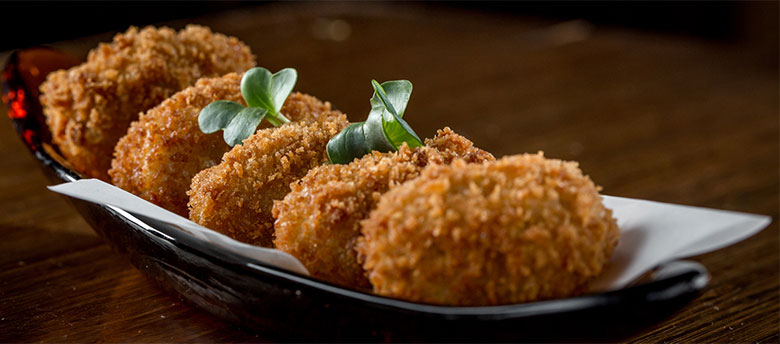
[Image Credit: Canela Bistro & Wine Bar]
Just a little hungry? Like variety? Want a fun place to meet friends for drinks and food? Check out your local tapas bars. These eateries, which originated in Spain, are springing up everywhere in the U.S.
What Are Tapas?
Tapas are small plates of food, more like snacks and appetizers than main courses. In Spain diners insist on food while drinking and these snacks serve the purpose. That’s why they are called tapas bars and not tapas restaurants.
The small plates of food are typically served with wine or sherry, but are also consumed with cocktails. In their simplest form, they can include olives, nuts, cheeses or sliced meats. More elaborate tapas include small servings of stews, seafood and chicken.
Hearty selections include Tortilla Espanola (a type of Spanish omelet), Patatas Bravas (potatoes in a spicy sauce), or Croquettes de Jamon (ham croquettes).
These snacks are made to facilitate conversation. In Spain, tapas bars are lively, social places. The small plates are easy to carry around so diners can take them as they move from one group to another. The mini-servings are an excellent accompaniment with alcohol, especially between major meals.
History of Tapas
What is certain is that tapas have been part of Spanish cuisine for centuries. Less clear is how they originated. There are three main legends. The first says in the 13th Century, Spain’s King Alfonso X, the Wise, was served wine on a windy day. The tavern owner placed a slice of ham on top to keep out the dust. He was so impressed, he always had food with his wine in the years to come.
Another legend says the king was tired of the drunkenness around him. He decreed that everyone drinking wine must also eat food, whatever the time of day. The third says that like the good king he was, he worried about his peasants. They often had only enough money for food or for drink, and often chose the second. To keep them healthy, he made it a law that food be always served with wine.
Tapas in Spain and America
In Spain, dinner is traditionally served late at night. In fact, it is common to start as late as 10 p.m. Lunch is served early afternoon, so that makes a lot of hours with no food. Tapas fill in nicely. Their small size is offset by the heartiness of the menu selections. Food with the wine also helps diners avoid getting tipsy during the day.
In the U.S., tapas fill a different niche in the culinary day. The happy hour culture happily adopted tapas. After a day in the cubicle, it is fun to compare notes with friends over a cocktail or glass of wine and a selection of tapas.
Tapas bars have also become a dinner or lunch destination. Diners enjoy ordering a variety of tapas to make a single meal.
What U.S. Tapas Bars Can Learn from Spain
Spain has two sizes of plates for diners. Tapas are a size meant for one person. Racciones are meant to feed three or four. Each is priced to fit its size. However, in this country tapas bars tend to price the small servings, meant for one, at prices more suitable to racciones. This automatically limits the sharing, which is a standard practice in Spanish tapas bars.
Spain also has another civilized touch that U.S. restaurants could adopt. Spanish tapas bars often include a tapa for free with the purchase of wine or beer. U.S. restaurants aren’t known for offering anything for free.
In many Spanish towns, there are groups of tapas bars close together. It is standard practice for diners to eat the specialty at one tapas bar, then walk over to the next to try their offering, and on to the next. Each stop involves one tapa and a glass of wine. Tapas bars are seldom so close in U.S. cities, and driving, not walking is the standard way to get around.
But the U.S. does get one thing right, the flavor. Diners familiar with both countries speak highly of the quality of the selections in U.S. tapas bars.
If you like variety and socializing, meet your friends at the local tapas bars. It is the perfect setting for good conversation and interesting food.